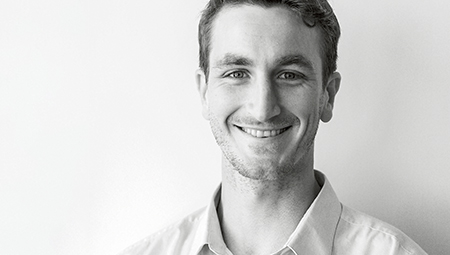The idea is as simple as it is impressive. Reminiscent of a kite, a thermal imaging camera attached to a drone is positioned over a burning building. This enables the firefighters on the ground to localise the seat of the fire and find anyone still inside the building, thus optimally organise their fire-fighting efforts. Fires can be more quickly extinguished, those trapped more rapidly saved and the firefighters themselves protected from unnecessary dangers. Perspective Robotics AG’s Fotokite drone has made the dream a reality.
The Swiss-American start-up—a spin-off company from the Swiss Federal Institute of Technology (ETH) in Zurich—has been researching and developing the concept since 2014. CEO Chris McCall made the move from San Diego Bay to the banks of the Limmat River to drive forward his vision of a rescue drone. “Zurich is way ahead when it comes to drone research. There is enormous potential for cutting-edge research and development in the field of flight robotics here.” Full of pride, he goes on to list the benefits of the Fotokite compared to free-flying alternatives. “The fact that the Fotokite is wired means it’s connected to an energy source and can therefore stay in the air indefinitely, and without any heavy batteries, it’s pretty safe. Plus there aren’t the same worries about fly-aways or crashing because our system doesn’t rely on GPS or RF communications.”


We are offering a stand-alone system that can be used at anytime, anywhere.
Chris McCall, CEO,
Perspective Robotics AG
The Fotokite Sigma has been in the test phase since 2018 and consists of a suitcase-style ground station and a hexacopter—a drone with six rotors. On board, there are both thermal imaging and a standard video cameras. The cable’s maximum range is 45 metres and the whole system is controlled from a ruggedized tablet. The altitude and cameras are easy to configure while take-off, flight and landing happen fully autonomously at the push of a button. This means the emergency services can fully concentrate on analysing the images and deciding the best course of action. When a response is finished, Fotokite returns to the ground station. “We are offering a stand-alone system that can be used at any time, anywhere”, explains Chris McCall.
What in principle sounds easy—arrive on scene, push a button to launch, set an altitude and away the drone goes—was actually very tricky to realise according to Chris McCall. Up to 50 specialists aren’t working on the system for nothing. The team includes aerospace engineers from Bavaria, flight controls specialists from Switzerland and Italy, and American robotics specialists in New York and Colorado. The common language is English and the common construction tool is the SOLIDWORKS 3D software solution.
“The 3D CAD software we use is very intuitive”; says Chris McCall. “Even those who have never worked with it before quickly get the hang of it”. From carbon frames with integrated electronics to the sheet metal for the camera mount, all in-house mechanical designs have been constructed using SOLIDWORKS. One of the biggest challenges was the spooling retractor mechanism for the cable that keeps the Fotokite tethered to the ground station. The cable doesn’t only power the drone, but also transmits control signals so that, for example, the exact altitude can be set. At the start, the team experimented with several concepts, and as time and reliability testing went on, it became clear which mechanical solution would be best suited to the job. “We designed this pretty complex electro-mechanical mechanism with SOLIWORKS”, says Chris McCall. “It was one of the ground station’s most intricate systems.”

Thanks to SOLIDWORKS product data management, multiple users can work on the project in parallel without causing chaos, which is particularly important at start-ups where a lot is happening—day and night. While the drone’s rough shape, maximum total weight, and how it would work were determined early on, improvements were made almost every day. SOLIDWORK’s central data safe helped keep Fotokite’s construction data safe and sound. Personalised access rights guarantee that the right user can access the data at the right time while version controls ensure that everyone involved is working with the latest version to prevent errors and having to re-work the 3D model. Interim versions can be defined without having to go without potential additional improvements.
The go-to-market strategy also looks promising. Perspective Robotics AG, headquartered in Zurich with branches in Syracuse, New York, and Boulder, Colorado, has already received extensive recognition for its vision with the start-up being awarded the 2015 Qualcomm European Qprize, winning the 2017 euRobotics Tech Transfer award, and coming first in the Genius NY competition in 2018. Attracted by this success, Credit Suisse and Sony have recently invested in Perspective Robotics. However, the most recent accolade and greatest commercial success has been the integration of the Sigma models into vehicles made by Pierce Manufacturing which is one of the leading suppliers of fire engines in North America. Chris McCall: “The operational freedom given to public safety teams in the US is one of the reasons for the growing success of the product over there. This means that firefighters and public safety teams can use the Fotokite system in real-life scenarios without significant barriers related to regulations and training. We have recently begun expanding into additional markets as well, and are excited to serve the public safety teams across Europe moving forward.”

This is an excerpt of an article in the print edition of Bechtle update 01/2020.
Contact person.
Susanne Eickhoff
Marketing Manager
Solid Solutions AG
susanne.eickhoff@solidsolutions.ch
Newsletter.
Get the best from the Bechtle update every two months directly into your mailbox. Click here to register:
